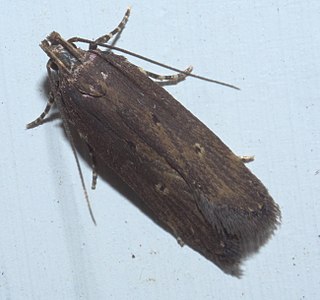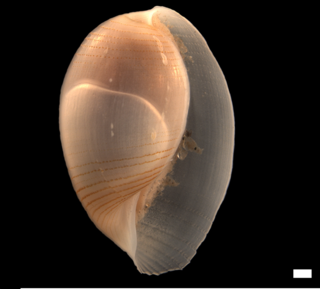
Chionodes is a genus of moths of the family Gelechiidae. It is distributed throughout much of the world. The larvae of many species use the Douglas fir as a host plant.
Chionodes petalumensis is a species of moth in the family Gelechiidae. It is found in North America from southern British Columbia to California, Arizona and Colorado.

Pinguicula orchidioides is a perennial rosette-forming insectivorous herb native to Mexico and Guatemala. A species of butterwort, it forms summer rosettes of flat, succulent leaves up to 5 centimeters (2 in) long, which are covered in mucilaginous (sticky) glands that attract, trap, and digest arthropod prey. Nutrients derived from the prey are used to supplement the nutrient-poor substrate that the plant grows in. Uniquely among Pinguicula species from the Americas, p. orchidioides produces gemma-like basal buds which elongate into stolons and serve as a means of asexual reproduction. In the winter the plant forms a non-carnivorous rosette of small, fleshy leaves that conserves energy while food and moisture supplies are low. Single purple flowers appear between July and September on upright stalks up to 22 centimeters long.

Pinguicula, commonly known as butterworts, is a genus of carnivorous flowering plants in the family Lentibulariaceae. They use sticky, glandular leaves to lure, trap, and digest insects in order to supplement the poor mineral nutrition they obtain from the environment. Of the roughly 80 currently known species, 13 are native to Europe, 9 to North America, and some to northern Asia. The largest number of species is in South and Central America.

Chionodes discoocellella, the eyeringed chionodes moth, is a moth in the family Gelechiidae. It is found in the United States, where it has been recorded from Maine to South Dakota, Florida, Texas and Colorado.

Chionodes fuscomaculella is a moth in the family Gelechiidae. It is found in North America, where it has been recorded from Nova Scotia and Quebec to Florida, south-western Wisconsin, eastern Texas and eastern Oklahoma.
Chionodes gilvomaculella is a moth in the family Gelechiidae. It is found in North America, where it has been recorded from Nova Scotia and southern Ontario to West Virginia and Ohio.

Chionodes obscurusella, the boxelder leafworm moth, is a moth in the family Gelechiidae. It is found in North America, where it has been recorded from Nova Scotia to Manitoba, south to North Carolina and Oklahoma.
Chionodes psiloptera is a moth in the family Gelechiidae first described by William Barnes and August Busck in 1920. It is found in North America, where it has been recorded from Quebec to British Columbia and then to Alaska, eastern Washington, Montana and New York.
Chionodes whitmanella is a moth in the family Gelechiidae. It is found in North America, where it has been recorded from south-western Manitoba and eastern Washington to Colorado, Arizona and California.
Chionodes johnstoni is a moth in the family Gelechiidae. It is found in North America, where it has been recorded from California. The Global Lepidoptera Names Index has it as a synonym of Chionodes gilvomaculella.
Chionodes scotodes is a moth in the family Gelechiidae. It is found in Sonora, Mexico.
Chionodes cacoderma is a moth in the family Gelechiidae. It is found in Mexico (Guerrero).
Chionodes chlorocephala is a moth in the family Gelechiidae. It is found in North America, where it has been recorded from New Mexico, California and Mexico.
Chionodes perissosema is a moth in the family Gelechiidae. It is found in Argentina.
Chionodes tannuolella is a moth in the family Gelechiidae. It is found in southern Siberia.
Chionodes sagayica is a moth in the family Gelechiidae. It is found in Russia. The Global Lepidoptera Names Index has this species as a synonym of Chionodes fumatella.

Roxania is a genus of gastropods belonging to the family Alacuppidae.






